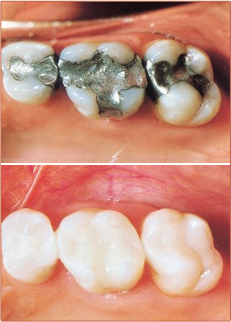


 Porcelain Veneers
Porcelain Veneers Teeth Whitening
Teeth Whitening Bonding
Bonding Tooth Colored Fillings
Tooth Colored Fillings Orthodontics
Orthodontics Gum Contouring
Gum Contouring Fillings
Fillings  On lays and Inlays
On lays and Inlays Crowns and Bridges
Crowns and Bridges Denture
Denture Extractions and Bone Grafts
Extractions and Bone Grafts Dental Implants
Dental Implants Periodic Checkups
Periodic Checkups Scaling and Root Planing
Scaling and Root Planing  Custom Night and Sports Guards
Custom Night and Sports Guards Snoring and Sleep Apnea
Snoring and Sleep Apnea Root Canal Treatment
Root Canal Treatment  Sealants
Sealants  Routine Checkup
Routine Checkup Fluoride Application
Fluoride Application Extractions
Extractions Space Maintainers
Space Maintainers Porcelain Fused Metallic Crown
Porcelain Fused Metallic Crown Dental Counseling
Dental Counseling Smile Makeover
Smile Makeover Neuromuscular Dentistry
Neuromuscular Dentistry Sedation Dentistry
Sedation Dentistry Laser Dentistry
Laser Dentistry Digital Dentistry
Digital Dentistry Relaxation Dentistry
Relaxation Dentistry
“Composite resin” fillings are
an aesthetic, lasting, alternative to traditional silver/mercury amalgam fillings. These are tooth colored and bonded to the surrounding tooth structure making them suitable for front and back teeth.
Teeth filled with “composite resin” tend to be stronger as it bonds to the surrounding tooth, while a tooth filled with amalgam may be weaker and result in cracking of the remaining tooth structure.
Few Type of Tooth-colored Dental Fillings are as follows:
1. Composite Fillings
Composite fillings are also called plastic or white fillings. Getting this kind of filling depends on where the tooth is in your mouth. We bite down hard on our back teeth (molars), so a plastic filling may not be a good choice. Talk to your dentist about other options.
To place this filling, your dentist cleans all decay from the tooth and puts a glue (or bonding material) on the inside of the hole. Composite resin is put into the hole in thin layers. Each layer gets hard with the help of a special light that your dentist holds over the tooth. When the last layer of the filling is hard, your dentist shapes the filling so it looks and feels natural.
- Advantages
- Disadvantages
2. Glass Ionomer Materials
Glass ionomer materials are only used in teeth where you do not bite down hard. There have not been many studies about how long this kind of filling lasts. Newer forms of the filling may be stronger and last longer. Research is underway to evaluate the effectiveness of these materials.
- Advantages
- Disadvantages
3. Porcelain Materials
Porcelain materials are the most common type of dental ceramic used by dentists. They are hard and brittle. Porcelain and metal can be combined to make a strong, tooth-colored crown.
Dental porcelain is made in a dental lab. Unless you have a bad tooth-grinding habit or some other problem, a combination of porcelain and metal can be used anywhere in the mouth.
- Advantages
- Disadvantages

